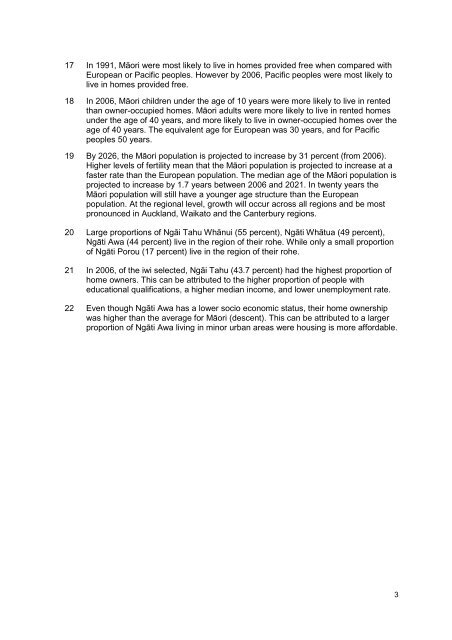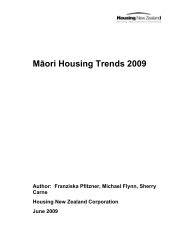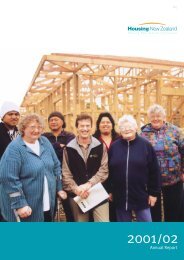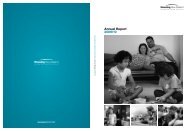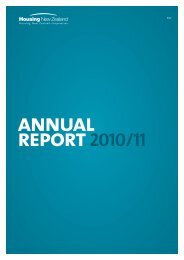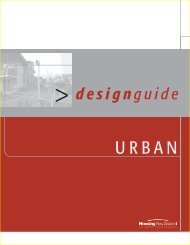higher median weekly income than those with only a school qualification or without aqualification.10 In 2006, about 13 percent of all Māori households were overcrowded,accommodating about 23 percent of the Māori population. The overall trend incrowding for Māori over the past two decades shows a decline, and has done so ata greater rate than for Pacific households. However, the disparity between thecrowding level of Europeans and Māori remains the same. In 2006, four times asmany Māori as European households were crowded. Nearly six times as manyMāori as European people lived in crowded households.11 In 2006, about 12 percent of the Māori population resided in <strong>Housing</strong> <strong>New</strong> <strong>Zealand</strong>Corporation (Corporation) housing. This compares to two percent of the Europeanpopulation, and 26 percent of the Pacific population.12 Over the past two decades housing has become less affordable for Māori. In 1988,eight percent of Māori households were paying more than 30 percent of their incomein housing costs, and by 2007 this figure was 29 percent. In 2004, housingaffordability was similar for Māori, European, and Pacific households for the firsttime. However by 2007, housing affordability for Māori households had decreased ata greater rate than that for European households, and at a similar rate to that forPacific households.13 In December 2009, Māori accounted for 27 percent of all AccommodationSupplement (AS) recipients. When compared with European, and Pacific ASrecipients, the proportion of Māori AS recipients who owned their home is smallest,and the proportion of single parents is highest. The number of people receiving theAS significantly increased between 2008 and 2009, increasing for Māori by 23.2percent, for European by 18.2 percent, and Pacific peoples by 29.3 percent.14 In December 2009, Māori were the Corporation’s second largest occupant groupwith 75,659 tenant household members. Māori were less likely to reside inCorporation housing when over the age of 65 years compared to Pacific andEuropean tenant household members. More than half of all Māori tenant householdmembers were children under the age of 20 years living with their families. This wasalso true for Pacific tenant household members, but compared to only 37 percent ofEuropean tenant household members. Being a single parent was the most commonhousehold type for Māori tenant household members, accounting for 29.7 percent.Europeans and Pacific tenants had a considerably lower proportion of singleparents.15 In December 2009, Māori applicant household members represented the secondlargest group of all people on the Corporation’s waiting list (10,023 applicanthousehold members) next to Pacific peoples. The majority of members of Māoriapplicant households were in severe housing need (A and B priority), which wasalso true for members of Pacific but not for members of European applicanthouseholds.16 Between 1991 and 2006, home ownership rates declined. While this was true for allethnic groups, home ownership rates have been declining at a greater rate for Māori(by 13.4 percent) than for Europeans (by 9 percent), but similar to Pacific peoples(by 14.5 percent). Furthermore in 2006, regardless of geographical location, age orincome, less Māori (and Pacific peoples) than Europeans were living in owneroccupiedhomes. Conversely more Māori (and Pacific peoples) were living in rentedhomes.2
17 In 1991, Māori were most likely to live in homes provided free when compared withEuropean or Pacific peoples. However by 2006, Pacific peoples were most likely tolive in homes provided free.18 In 2006, Māori children under the age of 10 years were more likely to live in rentedthan owner-occupied homes. Māori adults were more likely to live in rented homesunder the age of 40 years, and more likely to live in owner-occupied homes over theage of 40 years. The equivalent age for European was 30 years, and for Pacificpeoples 50 years.19 By 2026, the Māori population is projected to increase by 31 percent (from 2006).Higher levels of fertility mean that the Māori population is projected to increase at afaster rate than the European population. The median age of the Māori population isprojected to increase by 1.7 years between 2006 and 2021. In twenty years theMāori population will still have a younger age structure than the Europeanpopulation. At the regional level, growth will occur across all regions and be mostpronounced in Auckland, Waikato and the Canterbury regions.20 Large proportions of Ngāi Tahu Whānui (55 percent), Ngāti Whātua (49 percent),Ngāti Awa (44 percent) live in the region of their rohe. While only a small proportionof Ngāti Porou (17 percent) live in the region of their rohe.21 In 2006, of the iwi selected, Ngāi Tahu (43.7 percent) had the highest proportion ofhome owners. This can be attributed to the higher proportion of people witheducational qualifications, a higher median income, and lower unemployment rate.22 Even though Ngāti Awa has a lower socio economic status, their home ownershipwas higher than the average for Māori (descent). This can be attributed to a largerproportion of Ngāti Awa living in minor urban areas were housing is more affordable.3


